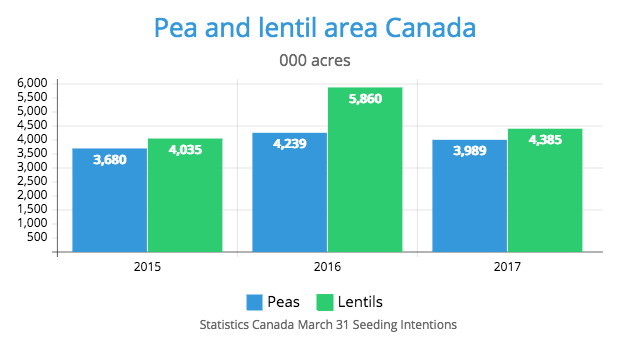Pulse crop acres will be down more than analysts expected in 2017, according to Statistics Canada’s seeding intentions report.
But some analysts think lentil acres in particular are being under-estimated for a variety of reasons.
According to the March survey of 11,600 farmers, growers plan to seed 4.39 million acres of lentils, down 25 percent from last year and 3.99 million acres of peas, a six percent drop.
Jon Driedger, senior market analyst with FarmLink Marketing Solutions, said most analysts were forecasting a decrease in lentil acres. The average estimate was 5.1 million acres, down from 5.86 million last year.
Read Also

Trump’s tariffs take their toll on U.S. producers
U.S. farmers say Trump’s tariffs have been devastating for growers in that country.
“That was a bigger drop than just about anyone was expecting,” he said.
CLICK HERE FOR STORY ON REST OF STATSCAN SEEDING NUMBERS
Driedger believes part of the problem was the survey was conducted in the last half of March when the pulse industry was still under threat of losing access to the Indian marketplace over a non-tariff trade barrier.
“There was a bit of a cloud over the pulse sector during that time,” he said.
“Some of that stuff has been cleared up since then.”
That’s why he believes lentil acres will be higher in subsequent reports.
Stat Publishing said there is a tendency most years for lentil acres to rise between the first and final estimates of the crop.
They have climbed an average of 15 percent over the last three years, which would negate much of this year’s estimate of a 25 percent drop.
Chuck Penner, analyst with LeftField Commodity Research, said the guesswork was harder than usual this year with pulses.
“I knew it was a bit of a crapshoot, especially on lentils, because the price signals are saying one thing but last year’s disease problems were saying the opposite,” he said.
Penner said a large lentil carryover from last year and an increase back to average yields would offset the drop in acres. Stat Publishing is forecasting 3.23 million tonnes of supplies, which is only three percent lower than 2016.
However, the supply of No. 2 or better lentils could still be constrained.
“The quality of that carryover is pretty lousy,” he said.
Penner believes pea supplies could be tight in 2017 if growers harvest an average crop versus the second biggest yield on record last year.
Driedger has no problem with Statistics Canada’s pea number. He was forecasting a slight increase but is fine with the small decline.
“New crop pea prices are okay, but not as sexy as they have been,” he said.
Chickpea plantings are expected to fall 13 percent to 140,000 acres. Beans will drop slightly to 260,000 acres.
Driedger said they are both such small acreage crops that he doesn’t put much faith in the numbers due to the small survey sample size.
“It really lends itself to big revisions going forward,” he said.
Flax acres are forecast to rise 19 percent to 1.12 million acres. Penner thinks it could end up a little larger than that.
He was surprised to see canaryseed acres climb four percent to 270,000 acres because prices have been dismal but growers are looking for a cereal crop that won’t be ravaged by fusarium.
Mustard plantings are forecast to plummet 26 percent to 390,000 acres. Penner thought it would have been even lower due to poor prices, while Driedger was surprised by the magnitude of the drop.
Sunflower seed is forecast to be down 29 percent to 50,000 acres. The small sample size argument is even more pronounced for this crop than chickpeas and beans.
sean.pratt@producer.com
















